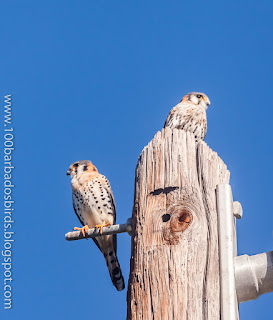 |
| A pair of American Kestrels @ Cabo Rojo, Puerto Rico |
 |
| Cell phone image of the dead Kestrel |
History in Barbados
Although Kestrels are considered common on the island of St.
Lucia, which is just over 100 miles SW of Barbados, it is very rare here (Birds of the West Indies …H. Raffaele et al).
As a matter of fact only twice has this
bird been recorded on the island, first at Chancery Lane on October 25, 1964 by
Maurice & Hazel Hutt and a pair recorded at Westbury Cemetery in April 1994
and turned over to Dr. Karl Watson (Birds of
Barbados … P.A. Buckley, E.B. Massiah et al ). Here is his account of the find as told by
him:
“I was contacted by individuals who said that they had seen a pair of small hawk like birds in Westbury cemetery that looked as if they were trying to nest. These individuals trap birds. In catching these two birds, one was killed. The other, they told me, they had caged and asked if I would come and look at it. I went down....the area off President Kennedy Drive..... and examined the bird which they had forced into a cage used for grass canaries (Grassland Yellowfinches). It was an American Kestrel, a bird I knew well from Jamaica, Haiti and Antigua. I offered them $100 for the cage and bird which they accepted. I called Michael Shemilt at Oughterson to ask him if I could take the kestrel to Oughterson. He agreed and on arrival, I transferred the bird to a much larger cage where it was kept for some time before being released.”
“I was contacted by individuals who said that they had seen a pair of small hawk like birds in Westbury cemetery that looked as if they were trying to nest. These individuals trap birds. In catching these two birds, one was killed. The other, they told me, they had caged and asked if I would come and look at it. I went down....the area off President Kennedy Drive..... and examined the bird which they had forced into a cage used for grass canaries (Grassland Yellowfinches). It was an American Kestrel, a bird I knew well from Jamaica, Haiti and Antigua. I offered them $100 for the cage and bird which they accepted. I called Michael Shemilt at Oughterson to ask him if I could take the kestrel to Oughterson. He agreed and on arrival, I transferred the bird to a much larger cage where it was kept for some time before being released.”
If you ever meet Dr. Watson face to face, ask him about the hair-raising parts of this rescue.
I will be on the lookout now for the fourth record of this
beautiful raptor. Let us hope it does
not take another 24 years to reappear.
No comments:
Post a Comment